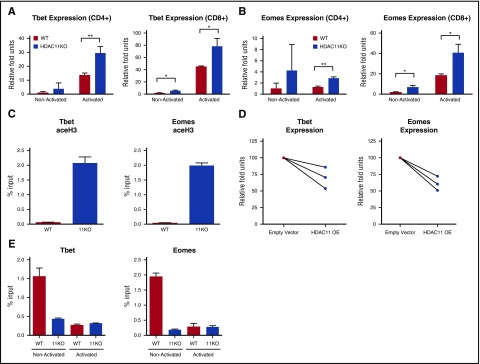Figure 3.
HDAC11 regulates the expression of Eomes and Tbet. (A) CD4+ and CD8+ T cells isolated from WT (black bars) or HDAC11KO (white bars) mice were left unstimulated or activated for 6 hours with αCD3/CD28–conjugated beads. Expression of Tbet mRNA was assessed by qRT-PCR. (B) Expression of Eomes was likewise assessed. Results shown are for 3 mice per group and are representative of 4 independent experiments. Error bars are ± SEM. (C) CD3+ T cells isolated from WT (black bars) and HDAC11KO (white bars) mice were chromatin immunoprecipitated for pan-acetylated histone 3. Pull-down at the Eomes and Tbet promoters was assessed by qRT-PCR and calculated as percent of IgG input. Values shown are representative of 2 independent experiments of 3 pooled mice. Error bars are SEM for 3 technical replicates. (D) CD3+ T cells isolated from 3 healthy human donors in 2 separate experiments were transfected by electroporation with an empty vector or HDAC11 overexpression plasmid. Cells were allowed to rest overnight and were then activated with αCD3/CD28–conjugated beads for 6 hours, at which time cells were lysed and expression of Tbet and Eomes was determined by qRT-PCR. Empty vector expression values were normalized to 100, and donor-matched overexpressing T-cell expression was graphed as relative fold units. (E) WT and HDAC11KO T cells were left unstimulated or activated via PMA and ionomycin for 1 hour and then chromatin immunoprecipitated for HDAC11. Pull-down was assessed by qRT-PCR and calculated as percent of IgG input. Values shown are representative of 2 independent experiments. Error bars show SEM for technical replicates. *P < .05; **P < .01. OE, overexpression.

